I’d heard the phrase before—global footprint—but did not realize, until yesterday, that a quite massive statistical effort has been underway since 2003 actually to measure what, using other words, would be called the sustainability of modern culture or measuring the Earth’s carrying capacity. The institution is called Global Footprint Network (GFN), with headquarters in Oakland, CA and an office in Geneva, Switzerland (link).
GFN obtains statistical data from around 230 nations, of which 150 are routinely available; it collects more than 6,000 data points from each; using these data it produces an Input-Output table showing resources consumed and resources either returned for reuse to the ecology or accumulated as waste. The global footprint is the cumulated from country data. The footprint is expressed as global hectares (gha) available and equivalent global hectares used. A global hectare is defined as a biologically productive area of land or water; approximately 12 billion hectares were available to humanity in 2008. A hectare, by the way. is 0.45 of an acre, about the size of a soccer field. If human activity uses no more or less than 12 billion gha our activities are sustainable. If human activity is greater than that, we have what GFN calls overshoot. In 2008, the calculated equivalent usage was 18.2 billion gha, which GFN abbreviates by saying that we are using 1.52 planet Earth-worth of resources—one and a half earths. That, of course, is not sustainable.
According to GFN, our way of life became unsustainable around 1971. By 2050, assuming a moderate “business as usual” projection, we will be using the equivalent of 2-3/4 earths to support our civilization. Definitely unsustainable.
There is a great deal on the site worth studying. I found it especially interesting that GFN does not treat fossil fuel use in the conventional manner (“we’re running out.”) Instead it views fossil fuel use from the perspective of our ability to handle its wastes, thus the Earth’s capacity to absorb our carbon dioxide production.
The Global Footprint Network is, ultimately, looking at population pressure—thus falls under a tradition begun by Thomas Robert Malthus (1766-1834). At the halfway point in Malthus’ life, circa 1800, world population was around 1 billion. We were then a long, long ways away form an unsustainable population. But we’ve increased population since then more than six times. And at some point somebody will be right. Unsustainablity will be reached. Does that mean that humanity will disappear? No. But the return to long-term sustainability will be neither pretty nor due to some clever gifts of technology, no matter how ingenious.







